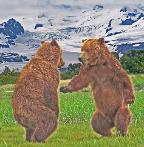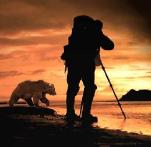| Moose, beaver, and other herbivores seen near bear viewing sites |

The piedmont (foot of the mountains) area between Mt. Mastadon and Redoubt
Bay provides great summer habitat for moose. But winter winds sweeping down
from the glaciers are so harsh that few moose can tolerate this habitat at that
time of year. So it is winter conditions, rather than summer conditions or
predation by wolves or bears, that appear to limit moose numbers in this area.
Bay provides great summer habitat for moose. But winter winds sweeping down
from the glaciers are so harsh that few moose can tolerate this habitat at that
time of year. So it is winter conditions, rather than summer conditions or
predation by wolves or bears, that appear to limit moose numbers in this area.

Site Visit Counter













| All wild sheep in Alaska are Dalls (left). Stone sheep (right) occur only south of Alaska in British Columbia. Big Horns live even farther south. |
Mountain sheep, and especially goats,survive best on
mountains of stratified (layered) rock that slopes inwards
pyramid), so that each layer provides a ledge along which
animals can walk; or which they can climb upwards. Such
rock is non-existant around Mt. Mastadon and other
regional volcanoes. Rock faces like the Otter Ramparts
instead slope outward from bottom to top, like upside down
stairs, making them difficult for sheep and goats to climb.
Much of the rock is andesite, the result of ancient magma
that cooled very quickly just below the Earth's surface.
mountains of stratified (layered) rock that slopes inwards
pyramid), so that each layer provides a ledge along which
animals can walk; or which they can climb upwards. Such
rock is non-existant around Mt. Mastadon and other
regional volcanoes. Rock faces like the Otter Ramparts
instead slope outward from bottom to top, like upside down
stairs, making them difficult for sheep and goats to climb.
Much of the rock is andesite, the result of ancient magma
that cooled very quickly just below the Earth's surface.

| The caribou in these photos, left to right, are a yearling fawn and its mother, and a bull. Muskoxen (below left) and bison (below right) occur only in other parts of Alaska. |
Visitors can see several beaver lodges along the shores of Otter and Weasel Lakes, or along the headwaters of Big River where it exits
| Bear Viewing Association To watch, to wonder, and to conserve [email protected] Ph/Fax (907) 260-9059 (Office) 39200 Alma Ave. Soldotna, AK 99669 |


Answers to questions commonly asked by wildlife viewers on the topics listed below: |
| Bear Viewing Association To watch, to wonder, and to conserve [email protected] Ph/Fax (907) 260-9059 (Office) 39200 Alma Ave. Soldotna, AK 99669 |

